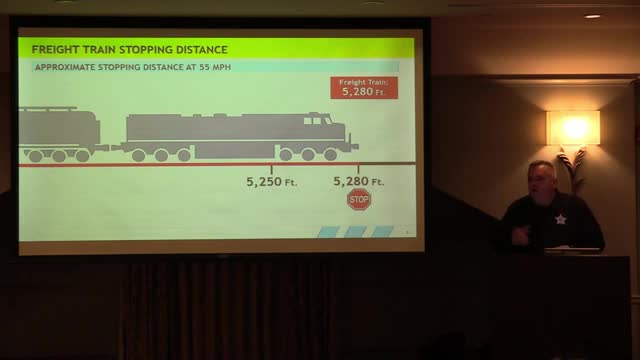Train Safety Urgency Amid Rising Risks at Crossings
August 02, 2024 | Barrington, Cook County, Illinois

This article was created by AI summarizing key points discussed. AI makes mistakes, so for full details and context, please refer to the video of the full meeting. Please report any errors so we can fix them. Report an error »

In a recent government meeting, officials discussed critical safety concerns regarding train crossings, particularly emphasizing the dangers posed by adverse weather conditions and the design of modern vehicles. The conversation highlighted how moisture from rain, ice, snow, and even wet leaves significantly increases stopping distances for vehicles, creating hazardous situations at railroad crossings.
Engineers expressed particular dread for fall conditions when wet leaves accumulate, making roads slippery and reducing visibility. The meeting underscored the stark contrast between older, heavier vehicles and today's lighter, plastic-bodied cars, which can weigh around 3,000 pounds. This shift in vehicle design raises safety concerns, especially when compared to the weight of freight trains, which can be up to 12 million pounds.
Officials also addressed the risks associated with passive railroad crossings, where drivers must yield to trains without the aid of gates or lights. They noted that many drivers may not see an approaching train until it's too late, especially in areas with obstructed views. The importance of adhering to traffic laws at crossings was stressed, including the legal implications of bypassing gates, which can result in hefty fines.
The meeting further highlighted the dangers of multiple tracks at crossings, where drivers may misjudge the arrival of trains, leading to potentially fatal accidents. A tragic incident from 1995 was recalled, where a school bus was struck by a train, resulting in the deaths of seven children. This incident serves as a grim reminder of the critical need for heightened awareness and adherence to safety protocols at railroad crossings.
Officials concluded by urging the public to remain vigilant and informed about train safety, particularly in areas with high traffic and complex crossing systems. The discussion emphasized that while advancements in rail and vehicle technology have improved overall safety, the responsibility ultimately lies with drivers to exercise caution and obey traffic regulations.
Engineers expressed particular dread for fall conditions when wet leaves accumulate, making roads slippery and reducing visibility. The meeting underscored the stark contrast between older, heavier vehicles and today's lighter, plastic-bodied cars, which can weigh around 3,000 pounds. This shift in vehicle design raises safety concerns, especially when compared to the weight of freight trains, which can be up to 12 million pounds.
Officials also addressed the risks associated with passive railroad crossings, where drivers must yield to trains without the aid of gates or lights. They noted that many drivers may not see an approaching train until it's too late, especially in areas with obstructed views. The importance of adhering to traffic laws at crossings was stressed, including the legal implications of bypassing gates, which can result in hefty fines.
The meeting further highlighted the dangers of multiple tracks at crossings, where drivers may misjudge the arrival of trains, leading to potentially fatal accidents. A tragic incident from 1995 was recalled, where a school bus was struck by a train, resulting in the deaths of seven children. This incident serves as a grim reminder of the critical need for heightened awareness and adherence to safety protocols at railroad crossings.
Officials concluded by urging the public to remain vigilant and informed about train safety, particularly in areas with high traffic and complex crossing systems. The discussion emphasized that while advancements in rail and vehicle technology have improved overall safety, the responsibility ultimately lies with drivers to exercise caution and obey traffic regulations.
View full meeting
This article is based on a recent meeting—watch the full video and explore the complete transcript for deeper insights into the discussion.
View full meeting
